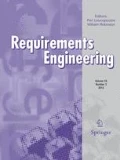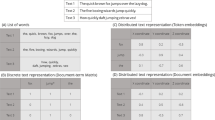Abstract
Improving the quality of software demands quality controls since the very beginning of the development process, i.e., requirements capture and writing. Automating quality metrics may entail considerable savings, as opposed to tedious, manually performed evaluations. We present some indicators for measuring quality in textual requirements, as well as a tool that computes quality measures in a fully automated way. We want to emphasize that the final goal must be measure to improve. Reducing quality management to the acquisition of a numerical evaluation would crash against the strong opposition of requirements engineers themselves, who would not see in the measurement process the aid of a counselor, but a policeman mechanism of penalties. To avoid this, quality indicators must first of all point out concrete defects and provide suggestions for improvement. The final result will not only be an improvement in the quality of requirements, but also an improvement in the writing skills of requirements engineers.







Similar content being viewed by others
References
Alexander I, Stevens R (2002) Writing better requirements. Addison-Wesley, Boston
Arthur LJ (1997) Quantum improvements in software system quality. Commun ACM 40(6):46–52
Berry DM, Bucchiarone A, Gnesi S, Lami G, Trentanni G (2006) A new quality model for natural language requirements specifications. In: Proceedings of the 12th international working conference on requirements engineering: foundation of software quality (REFSQ-06). Luxembourg, 5–6 June 2006. Held in conjunction with CAiSE’06
Braude E (2001) Software engineering. An object oriented perspective. Wiley, London
Boehm B (1981) Software engineering economics. Prentice-Hall, Englewood Cliffs
Bertolino A, Fantechi A, Gnesi S, Lami G, Maccari A (2002) Use case description of requirements for product lines. In: Proceedings of the international workshop on requirements engineering for product lines 2002—REPL’02. Held in conjunction with RE’02. Essen, Germany, 9 Sept 2002
Brooks FP (1987) No silver bullet. Essence and accidents of software engineering. IEEE Comput 20(4):10–19, April 1987. Reprinted in: Brooks FP The mytical man-month, essays on software engineering. Addison-Wesley, 1995 (20th anniversary edition)
Bucchiarone A, Gnesi S, Pierini P (2005) Quality analysis of NL requirements: an industrial case study. In: 13th IEEE international requirements engineering conference, pp 390–394. Paris, France, 29 Aug–2 Sept 2005
Cameron WB (1963) Informal sociology: a casual introduction to sociological thinking. Random House, New York
Christel M, Kang K (1992) Issues in requirements elicitation. Carnegie Mellon University, Software Engineering Institute. Technical report CMU/SEI-92-TR-012
Cortim. Lexior. http://www.cortim.com/lexior/
Deming WE (1986) Out of the crisis. MIT Press, Cambridge
Fabbrini F, Fusani M, Gnesi S, Lami G (2001) The linguistic approach to the natural language requirements quality: benefit of the use of an automatic tool. In: Proceedings of the 26th annual NASA Goddard software engineering workshop, pp 97–105
Fanmuy G, Roussel J-C, Szczepaniak R, Salinesi C, Dauron A, Picci L, Hammami O (2010) Requirements analysis and modeling process (RAMP) for the development of complex systems. In: 7th European systems engineering conference (EuSEC 2010). Stockholm, Sweden, 23–26 May 2010
Fanmuy G (2011) Requirements verification in industry. In: 17th international working conference on requirements engineering: foundations for software quality (REFSQ-2011), industry track. Essen, Germany, 28–30 March 2011
Fantechi A, Gnesi S, Lami G, Maccari A (2003) Applications of linguistic techniques for use case analysis. Requir Eng 8(3):161–170
Fernández Huerta J (1959) Medidas sencillas de lecturabilidad. Consigna 214:29–32
Flesch R (1948) A new readability yardstick. J Appl Psychol 32:221–233. Reprinted in: Rudolf Flesch. The art of readable writing. New York, 1949 (25th anniversary edition, revised and enlarged, Harper & Row, 1974)
Frank U (2006) Towards a pluralistic conception of research methods in information systems research. ICB-Research report no. 7, 2006. Institute for Computer Science and Business Information Systems, University Duisburg-Essen. Retrieved 19 May 2011 from http://www.icb.uni-due.de/fileadmin/ICB/research/research_reports/ICBReport07.pdf
Hevner AR, March ST, Park J, Ram S (2004) Design science in information systems research. MIS Q 28(1):75–105
HOOD. DESIRe. http://www.hood-group.com/en/products/tools/requirements-engineering/desirer/
Ibáñez M, Rempp H (1996) European user survey analysis. European Software Institute, ESPITI project, technical report TR95104
IBM. Rational DOORS. http://www-01.ibm.com/software/awdtools/doors/
IEEE Std 830-1998. IEEE recommended practice for software requirements specifications. http://www.ieeexplore.ieee.org/iel4/5841/15571/00720574.pdf
IEEE Std 982.2-1988. IEEE guide for the use of IEEE standard dictionary of measures to produce reliable software. http://www.ieeexplore.ieee.org/iel1/2596/983/00026479.pdf
James L (1999) Providing pragmatic advice on how good your requirements are—the precept ‘requirements councillor’ utility. In: Proceedings of the 9th INCOSE international symposium, Brighton, England, 1999
Kasser JE (2004) The first requirements elucidator demonstration (FRED) tool. Syst Eng 7(3):243–256
Kasser JE, Scott W, Tran XL, Nesterov S (2006) A proposed research programme for determining a metric for a good requirement. The conference on systems engineering research, Los Angeles, California, USA
Kincaid JP, Fishburne RP, Rogers RL, Chissom BS (1975) Derivation of new readability formulas (automated readability index, Fog count and Flesch reading ease formula) for navy enlisted personnel. Research branch report 8-75, Naval Air Station, Memphis, Tennessee, USA
Kiyavitskaya N, Zeni N, Mich L, Berry DM (2008) Requirements for tools for ambiguity identification and measurement in natural language requirements specifications. Requir Eng 13(3):207–239
Knowledge Reuse Research Group. Universidad Carlos III de Madrid. http://www.kr.inf.uc3m.es
Latimer-Livingston NS (2004) Market share: requirements management, worldwide, 2003 (executive summary). Gartner research, 1 July 2004. http://www.gartner.com/DisplayDocument?ref=g_search&id=452522
Loucopoulos P, Karakostas V (1995) Systems requirements engineering. McGraw-Hill, New York
Marrero M, Sánchez-Cuadrado S, Fraga A, Llorens J (2008) Applying ontologies and intelligent text processing in requirements reuse. First workshop on knowledge reuse (KREUSE’08), pp 25–29. Held in conjuction with 10th international conference on software reuse (ICSR’08). Beijing, China, 2008
Marsick VJ, Volpe M (eds) (1999) Informal learning on the job. Berrett-Koehler Publishers, San Francisco
Mich L, Franch M, Inverardi PLN (2004) Market research for requirements analysis using linguistic tools. Requir Eng 9(1):40–56
NASA Goddard Space Flight Center. ARM automated requirement measurement tool. http://www.sw-assurance.gsfc.nasa.gov/disciplines/quality/index.php#tools
Popescu D, Rugaber S, Medvidovic N, Berry DM (2007) Reducing ambiguities in requirements specifications via automatically created object-oriented models. In: Proceedings of the 14th monterey workshop on requirements analysis. Monterey, CA, USA, 10–13 Sept 2007. Springer LNCS 5320, pp 103–124
Pressman RS (2005) Software engineering: a practitioner’s approach, 6th edn. McGraw-Hill Pub Co., New York
Redish JC, Seizer J (1985) The place of readability formulas in technical communication. Techn Commun 32(4):46–52
Redish JC (2000) Readability formulas have even more limitations than Klare discusses. ACM J Comput Documentation 24(3):132–137
Rosenberg LH (2001) Generating high quality requirements. In: Proceedings of the AIAA space 2001 conference and exposition, AIAA paper 2001-4524. American Institute of Aeronautics and Astronautics, Albuquerque, NM, 28–30 Aug 2001
Sadraei E, Aurum A, Beydoun G, Paech B (2007) A field study of the requirements engineering practice in Australian software industry. Requir Eng 12(3):145–162
Sommerville I (2004) Software engineering, 7th edn. Pearson-Addison Wesley, Boston
Sunny Hills. Requirements assistant. http://www.requirementsassistant.nl/
SWEBOK (2004) Guide to the Software Engineering Body of Knowledge. IEEE Computer Society, 2004. http://www.computer.org/portal/web/swebok
The Standish Group (2003) Chaos report, 2003. http://www.standishgroup.com/
The Reuse Company. RQA requirements quality analyzer. http://www.reusecompany.com/index.php?option=com_content&view=category&layout=blog&id=171&Itemid=75&lang=en
University of Pisa. QuARS quality analyzer for requirement specifications. http://www.quars.isti.cnr.it/
University of South Australia. TigerPro. http://www.therightrequirement.com/TigerPro/TigerPro.html
Vaishnavi VK, Kuechler W (2008) Design science research methods and patterns: innovating information and communication technology. Auerbach Publications, Philadelphia
Wilson WM, Rosenberg LH, Hyatt LE (1997) Automated Analysis of Requirement Specifications. In: Proceedings of the 19th international conference on software engineering-ICSE’97, 17–23 May 1997, Boston, MA, USA, pp 161–171
Winter R (2008) Design science research in Europe. Eur J Inf Syst 17:470–475
Zeist R, Hendriks P (1996) Specifying software quality with the extended ISO model. Softw Qual J 5(4):273–284
Acknowledgments
This research is supported through the Spanish Ministerio de Ciencia y Tecnología, Project TIN2007-67153, “SEMSE: SEmantic Metadata SEarch” (“Desarrollo de un sistema de recuperación conceptual mediante niveles semánticos en la representación de esquemas de metadatos”).
Author information
Authors and Affiliations
Corresponding author
Rights and permissions
About this article
Cite this article
Génova, G., Fuentes, J.M., Llorens, J. et al. A framework to measure and improve the quality of textual requirements. Requirements Eng 18, 25–41 (2013). https://doi.org/10.1007/s00766-011-0134-z
Received:
Accepted:
Published:
Issue Date:
DOI: https://doi.org/10.1007/s00766-011-0134-z




